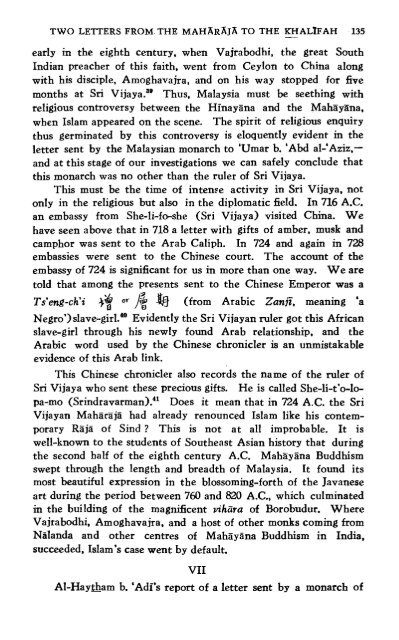TWO LETTERS FROM THE MAHARAJA TO THE KHALIFAH
TWO LETTERS FROM THE MAHARAJA TO THE KHALIFAH
TWO LETTERS FROM THE MAHARAJA TO THE KHALIFAH
You also want an ePaper? Increase the reach of your titles
YUMPU automatically turns print PDFs into web optimized ePapers that Google loves.
<strong>TWO</strong> <strong>LETTERS</strong> <strong>FROM</strong> <strong>THE</strong> <strong>MAHARAJA</strong> <strong>TO</strong> <strong>THE</strong> KHAL~FAH - 135<br />
early in the eighth century. when Vajrabodhi, the great South<br />
Indian preacher of this faith, went from Ceylon to China along<br />
with his disciple. Amoghavajra, and on his way stopped for five<br />
months at Sri Vijaya.=@ Thus, Malaysia must be seething with<br />
religious controversy between the Hinayana and the Mahzyiina,<br />
when Islam appeared on the scene. The spirit of religious enquiry<br />
thus germinated by this controversy is eloquently evident in the<br />
letter sent by the Malaysian monarch to 'Umar b. 'Abd al-'Aziz.-<br />
and at this stage of our investigations we can safely conclude that<br />
this monarch was no other than the ruler of Sri Vijaya.<br />
This must be the time of intenee activity in Sri Vijaya, not<br />
only in the religious but also in the diplomatic field. In 716 A.C.<br />
an embassy from She-li-fo-she (Sri Vijaya) visited China. We<br />
have seen above that in 718 a letter with gifts of amber. musk and<br />
camphor was sent to the Arab Caliph. In 724 and again in 728<br />
embassies were sent to the Chinese court. The account of the<br />
embassy of 724 is significant for us in more than one way. We are<br />
told that among the presents sent to the Chinese Emperor was a<br />
Ts'eng-ch'i 33 @ (from Arabic Zanji, meaning 'a<br />
~egro')slave-girl." Evidently the Sri Vijayan ruler got this African<br />
slave-girl through his newly found Arab relationship, and the<br />
Arabic word used by the Chinese chronicler is an unmistakable<br />
evidence of this Arab link.<br />
This Chinese chronicler also records the name of the ruler of<br />
Sri Vijaya who sent these precious gifts. He is called She-li-t'o-lo-<br />
pa-mo (Srindra~arman).~' Does it mean that in 724 A.C. the Sri<br />
Vijayan MahBrizjzi had already renounced Islam like his contem-<br />
porary RBja of Sind ? This is not at all improbable. It is<br />
well-known to the students of Southeast Asian history that during<br />
the second half of the eighth century A.C. Mah~yZna Buddhism<br />
swept through the length and breadth of Malaysia. It found its<br />
most beautiful expression in the blossoming-forth of the Javanese<br />
art during the period between 760 and 820 A.C., which culminated<br />
in the building of the magnificent vihiira of Borobudur. Where<br />
Vajrabodhi, Amoghavajra, and a host of other monks coming from<br />
Nalanda and other centres of Mahayana Buddhism in India,<br />
succeeded. Islam's case went by default.<br />
VII<br />
Al-Haybam b. 'Adi's report of a letter sent by a monarch of
















